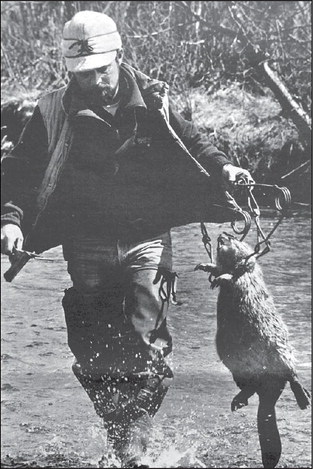Public snaps back at beaver trapping changes
John Branca trapping beaver in April 1986. Thirty-three years later, the Hoback resident says he disapproves of a Wyoming Game and Fish Department plan to open up some Jackson Hole stream systems to unlimited beaver trapping. TED WOOD / NEWS&GUIDE FILE
Following public objections and opposition from some unlikely camps, wildlife managers are walking back plans to open up an array of Jackson Hole streams to unlimited beaver trapping.
Portions of Ditch Creek, Willow Creek and Game creeks were all positioned to be open to any trapper possessing an over-the-counter license but will now be recommended for a complete closure.
Draft regulations that will advance next month to the Wyoming Game and Fish Commission will still recommend that Fall, Mosquito and Dog creeks — now collectively managed and restricted to a single trapper — be opened to any fur trapper who’s interested. Little Horse Creek falls into this same category.
Public insight gathered through the season-setting process and input from biologists prompted the revisions, Game and Fish spokesman Mark Gocke said.
“Limited quota is a management strategy that’s used when there’s fear of possible over-harvest, and our data shows that we’ve had a real drop-off of beaver harvest,” he said. “So it does not make sense to have limited quota anymore. It also restricts our ability to deal with problems.”
The revised draft regulations haven’t been published but will be posted to Game and Fish’s website in the next week or two, Gocke said. Until the proposal is issued, Gocke said it’s difficult to say which portions of Ditch Creek, Willow Creek and Game creek would be closed.
Detractors of Game and Fish’s original beaver trapping plans for the seven streams included one of the valley’s long-standing fur trappers, Hoback resident John Branca.
“I think it would be foolish to do away with the permits,” Branca told the News&Guide last week. “They serve a purpose.”
Branca said he was regularly trapping beavers in the early 1990s when Game and Fish changed the rules and capped the streams in question at a single trapper apiece.
“People would just pound them,” Branca recalled. “High fur prices drive problems, and these areas that they’re talking about are so accessible, where if the prices are ever to go up again I would worry about the rookies.”
The Game and Fish proposal to do away with the limited-quota licenses came after individuals acquired the exclusive permits through a lottery but then didn’t trap any beavers. Genuine fur trappers who won the permits but didn’t live locally and trap regularly were also a factor in the decision, Gocke said.
Last trapping season none of the four permits went to people who used them.



